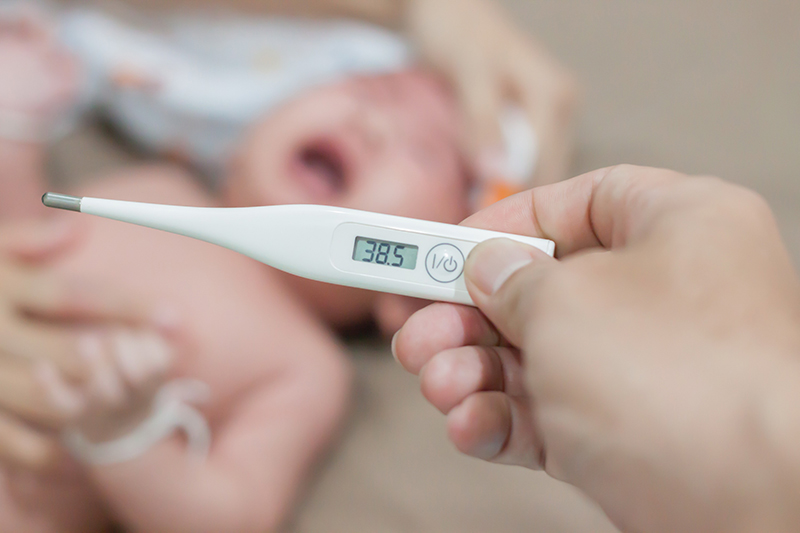Families For Life | Fever-Newborn

The normal body temperature range for children is 36.5°C-37.5°C. Fever happens when this body temperature goes above 37.5°C.
Causes of fever and high temperature in children
Children get fevers for all kinds of reasons. Most fevers and the illnesses that cause them last only a few days. But sometimes a fever will last much longer and might be the sign of an underlying chronic or long-term illness or disease.
Infections are by far the most common cause of fever in children. In general, fever is nature’s response to infection. It’s a good sign that your child’s body is fighting the infection.
Most childhood infections are caused by viruses, which are responsible for common colds and other upper respiratory tract infections, as well as the common infectious diseases of childhood, like chickenpox. These infections don’t last long and usually don’t need to be treated.
Some infections are caused by bacteria, which need treatment with antibiotics. These include certain ear and throat infections, urinary tract infections, pneumonia, blood infections and meningitis. A very sore throat with a fever can be caused by Streptococcus. If it isn’t treated with antibiotics, this infection can be dangerous and lead to things like rheumatic fever or heart damage.
There are other less common causes of fever. These include allergic reactions to drugs or vaccines, chronic joint inflammation, some tumours and gastrointestinal diseases like gastroenteritis.
Fever symptom
During the course of each day, body temperature goes up and down by up to 1°C. It’s usually lowest in the early hours of the morning, and highest in the late afternoon and early evening.
A fever or high temperature might come on slowly and rise over a few days, or it might rise very quickly. These things usually doesn’t have anything to do with the illness that causes the fever.
Fever in itself is rarely harmful. But the high temperature might make your child feel uncomfortable – he might have chills or shivering when his temperature is rising, and he might sweat when it’s falling. Sometimes he might become mildly dehydrated if he’s losing a lot of fluid from the fever and not drinking enough.
Febrile convulsions are seizures that can happen because of a high fever. They occur in about 3% of children between the ages of six months and five years. Children almost always outgrow febrile convulsions by the age of 4-5 years. Febrile convulsions have no long-term consequences, but if your child has a febrile convulsion, it’s best to talk to your General Practitioner (GP) about it.
If you think your child might have a fever, it’s important to know how to take your child’s temperature.
When to see your doctor about fever and high temperature
Babies under three months of age who develop a fever must be seen by a doctor immediately, because it’s harder to tell whether they have a serious underlying illness.
In children aged 3-12 months, fever might be a sign of a more significant illness, so seek medical advice within the same day.
In children over 12 months, seek medical attention if your child has a fever and:
looks sicker than before – more pale, lethargic and weak
has trouble breathing
becomes drowsy
refuses to drink, and is weeing less often (if your child has fewer than half the usual number of wet nappies, see a doctor).
complains of a stiff neck, persistent headache or light hurting her eyes
vomits persistently, or has frequent bouts of diarrhoea
doesn’t improve in 48 hours
suffers pain
is causing you to worry for any other reason.
Fever treatment
You should treat a fever only if it’s making your child uncomfortable. A fever will run its course regardless of treatment.
Generally, children handle fever well, but you can do a few things to make your child more comfortable:
Dress your child in light clothing.
If your breastfed child is younger than six months, offer him extra breastfeeds.
If your formula-fed child is younger than six months, offer her the usual amount of formula. You might need to feed her smaller amounts more frequently.
If your child is older than six months, keep breastfeeding or bottle-feeding. You can also offer your child clear fluids like water. If your child isn’t hungry while he has a fever, that’s OK.
Give your child liquid paracetamol in the recommended dose and frequency. If your child has more than the recommended dose it can cause liver damage.You can also give ibuprofen to children aged over three months. Do not give fever-lowering medication too often or for too long because side effects can occur.
If your child has a fever, the most important thing is to drink enough water to avoid dehydration. If you are worried your child is not drinking enough water, speak with your GP.
Do not give your child aspirin because it can make your child susceptible to Reye’s syndrome, a rare but potentially fatal illness. It can also cause serious illness or even death in children with chickenpox or the flu.
© raisingchildren.net.au, translated and adapted with permission